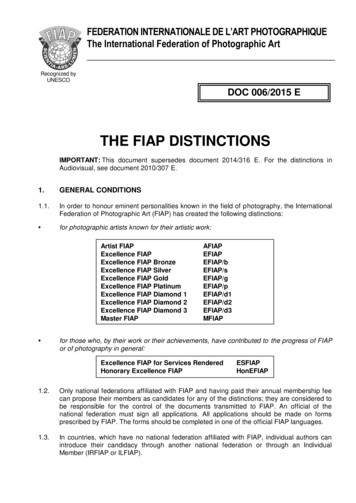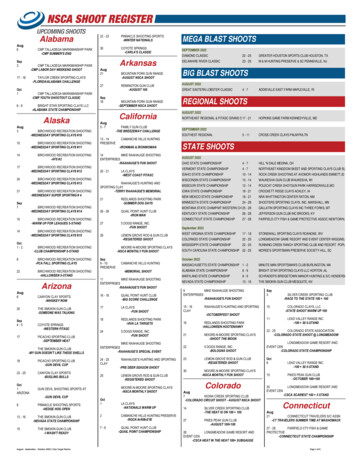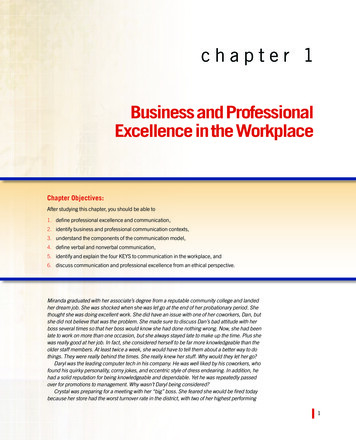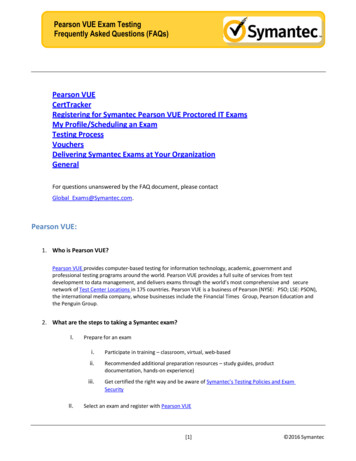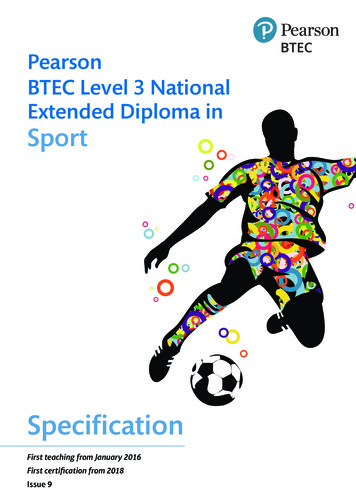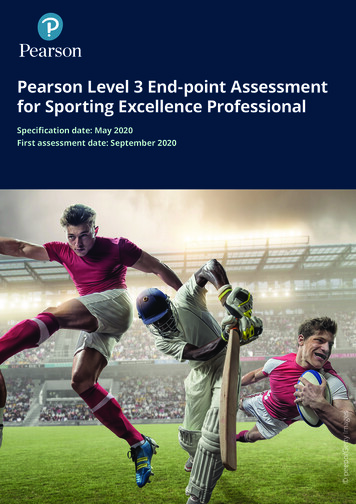
Transcription
Pearson Level 3 End-point Assessmentfor Sporting Excellence Professional peepo/Getty ImagesSpecification date: May 2020First assessment date: September 2020
About PearsonWe are the world’s learning company operating in 70 countries around the world with more than22,500 employees. We provide content, assessment and digital services to schools, colleges anduniversities, as well as professional and vocational education to learners to help increase their skillsand lifelong employability prospects. We believe that wherever learning flourishes so do people.References to third party material made in this specification are made in good faith. Pearson does notendorse, approve or accept responsibility for the content of materials, which may be subject to change, orany opinions expressed therein. (Material may include textbooks, journals, magazines and other publicationsand websites.)All information in this specification is correct at time of publication.ISBN 978 1 446 96633 4All the material in this publication is copyright Pearson Education Limited 2020
Collaborative developmentWe have worked with employers, training providers and professional bodies in thedevelopment of materials for this Level 3 Sporting Excellence Professional End-pointAssessment. We are grateful to all individuals who have generously shared their timeand expertise.UK Anti-Doping (UKAD) have provided support in the development of test contentaround K6 anti-doping.
ContentsPearson End-Point Assessments for Apprenticeship Standards1231Introduction1The Sporting Excellence Professional Apprenticeship3Overview3Sporting Excellence Professional End-point Assessment5Structure5Grading6Gateway requirements7Language of assessment7Preparing apprentices for End-point Assessment8End-point Assessment planning and scheduling9Reassessment10Booking reassessment10End-point assessment components11Component 1: Knowledge Test13Component 2: Practical Observation (with Q&A)17Component 3: Professional Interview (supported by a portfolio of evidence) 554Further information and useful publications715Contact us73Annexe A: Gateway Declaration Form75
Pearson End-Point Assessments for ApprenticeshipStandardsIntroductionOne of the most significant changes of the apprenticeship reform in England is theintroduction of an independent End-point Assessment.The End-point Assessment (EPA) is a synoptic assessment of the knowledge, skills andbehaviours outlined in the Apprenticeship Standard, and that have been developedthroughout the apprenticeship programme. The purpose of the EPA is to make surethe apprentice meets the standard set by employers and is fully competent in theoccupation.All apprentices must undertake the EPA at the end of the on-programme phase oftraining when their employer, and in some cases their training provider, is satisfiedthat they have met the “gateway” criteria to undertake the assessment. Apprenticeswill not be awarded the apprenticeship certificate until they have successfullycompleted the EPA.The EPA can only be delivered by a registered assessment organisation which must beindependent of the employer or any training provider involved in the delivery of theon-programme phase of the apprenticeship. All assessment decisions for the EPAmust be made by the independent assessment organisation.Pearson, as a registered assessment organisation, has been working closely withoccupational experts, employers and training providers in the development of EPAtools to ensure that they are: valid and appropriate to assess occupational competence in the relevant industryand will deliver reliable outcomes fair to all apprentices and help them to make progress in their lives manageable for apprentices and the industry and can be delivered effectively andefficiently.This specification contains the information needed to prepare apprentices for theLevel 3 Sporting Excellence Professional Apprenticeship EPA. (QN 603/5841/5)Pearson Level 3 End-point Assessment for Sporting Excellence ProfessionalSpecification – Issue 1 – May 2020 Pearson Education Limited 20201
2Pearson Level 3 End-point Assessment for Sporting Excellence ProfessionalSpecification – Issue 1 – May 2020 Pearson Education Limited 2020
1The Sporting Excellence ProfessionalApprenticeshipOverviewThe EPA in this specification relates to the Sporting Excellence ProfessionalApprenticeship.The apprenticeship is at Level 3 and is for apprentices working in the role of aSporting Excellence Professional in either football, rugby league, rugby union orcricket.Sporting Excellence Professionals are competent to perform consistently andeffectively in training environments and competitions related to their professionalsport. As such, they are part of a playing team supported and managed by a widermulti-disciplinary team including a manager/coach, skills coaches, physiotherapists,psychologists, nutritionists, strength and conditioning experts, and educational staff.They have high level of autonomy in terms of responsibility for what happens on thefield of play and need to be able to cope with extreme pressure.The purpose of the EPA is to confirm that the apprentice has met the required level ofknowledge, skills and behavioural standards set by employers and that they arecompetent in their role as a Sporting Excellence Professional.The typical duration for this apprenticeship is 18-24 months but this will depend onthe apprentices’ previous experience and access to opportunities to gain the full rangeof competences.The overall apprenticeship is graded as Fail/Pass/Distinction.To achieve the apprenticeship certificate, apprentices are required to completesuccessfully the: on-programme period of training and development, including achieving therequired Maths and English qualifications as set out in the Level 3 SportingExcellence Professional Assessment Plan. End-point Assessment (EPA) – Section 3 provides detailed information on the Endpoint Assessment for this apprenticeship.Pearson Level 3 End-point Assessment for Sporting Excellence ProfessionalSpecification – Issue 1 – May 2020 Pearson Education Limited 20203
The certificate for the apprenticeship is awarded by the Institute for Apprenticeshipsand Technical Education (IfATE), through a process administered by the Education andSkills Funding Agency (ESFA). As the assessment organisation, Pearson will claim thecertificate on behalf of the apprentices.Employers and/or training providers should familiarise themselves with therequirements of the apprenticeship and communicate these clearly to apprentices.To see the published Sporting Excellence Professional Apprenticeship Standard andassessment plan, please go to: standards/4Pearson Level 3 End-point Assessment for Sporting Excellence ProfessionalSpecification – Issue 1 – May 2020 Pearson Education Limited 2020
2Sporting Excellence Professional End-pointAssessmentStructureThe EPA for the Sporting Excellence Professional Apprenticeship consists of thefollowing three assessment components: Knowledge Test Practical Observation (with Q&A) Professional Interview (supported by a portfolio of evidence).The table below gives a summary of the structure of the EPA:End-point Assessment componentsKnowledge TestPractical Observation (with Q&A)Professional Interview (supported bya portfolio of evidence)DurationComponent grading90 minutesFail/Pass/Distinction3 hoursFail/Pass/Distinction90 minutesFail/Pass/DistinctionThe EPA must be completed within a maximum period of three months, after thegateway. In extenuating circumstances due to long-term injury or ill health, the EPAperiod can be extended at the discretion of the end-point assessment organisation(EPAO).The EPA components can be taken in any order, although the knowledge test willusually be scheduled first.There is detailed information about each of these EPA components in Section 3.Pearson Level 3 End-point Assessment for Sporting Excellence ProfessionalSpecification – Issue 1 – May 2020 Pearson Education Limited 20205
GradingEach of the three assessment components is individually graded. To achieve a pass, the apprentice must achieve a minimum of a pass in all threeassessment components. To achieve a distinction, the apprentice must achieve distinction in all threeassessment components.If an apprentice fails any component of their End-point Assessment, this will beclassed as an overall fail. However, they will only be required to resit/retake thecomponent they have failed and will not be required to resit/retake the whole Endpoint Assessment again (see Section 2: Reassessment).6Pearson Level 3 End-point Assessment for Sporting Excellence ProfessionalSpecification – Issue 1 – May 2020 Pearson Education Limited 2020
Gateway requirementsBefore progressing to the EPA, all apprentices must be signed off by their employer,through the ‘gateway’. This gateway sign off confirms that apprentices have the levelof occupational knowledge, skills and behaviours required to achieve theapprenticeship and that they are therefore ‘ready for EPA’. Employers should onlyrecommend apprentices for End-point Assessment when they are confident that theapprentices are ready.The stated Mathematics and English requirements form part of the gateway and mustbe achieved before apprentices attempt the End-point Assessment.Employers must complete an End-point Assessment Gateway Declaration Form(Annexe A), with the apprentice. The form and the associated gateway evidence willbe transferred to Pearson before the End-point Assessments take place. The formcaptures the mandatory prerequisites for the End-point Assessments and any otherorganisation-specific evidence, for example the confirmation of the apprentice’splaying position for the End-point Assessment. The assessments cannot take placeunless the relevant information and evidence are available.Evidence that the apprentices have met the gateway requirements must be providedto support the Gateway Declaration Form.Language of assessmentAll components of the EPA will be conducted in English.Should an apprentice require reasonable adjustments, this must be communicatedto the EPA delivery team at the gateway stage.Further information on the use of language in qualifications is available in ourUse of languages in qualifications policy document, available on our website at:qualifications.pearson.comPearson Level 3 End-point Assessment for Sporting Excellence ProfessionalSpecification – Issue 1 – May 2020 Pearson Education Limited 20207
Preparing apprentices for End-point AssessmentTo ensure that apprentices develop the knowledge, skills and behaviours thatunderpin occupational competence, it is recommended that they follow a structuredprogramme of training and development. The period of training and developmentshould be a minimum of 18-24 months and must include a minimum of 20 per centoff-the-job training, away from the day-to-day job.In order to prepare apprentices effectively, employers and/or training providersshould: have a good understanding of the Apprenticeship Standard and the structure andformat of the EPA – Section 3 of this specification gives detailed information abouteach EPA component plan and implement a learning and development programme based on theApprenticeship Standard, with regular reviews of progress and readiness, toensure apprentices develop the required knowledge, skills and behaviours use formative assessments and mock assessments to help prepare apprentices forthe EPA.8Pearson Level 3 End-point Assessment for Sporting Excellence ProfessionalSpecification – Issue 1 – May 2020 Pearson Education Limited 2020
End-point Assessment planning and schedulingEmployers and/or training providers must have an agreement in place to conductEnd-point Assessments with Pearson, and apprentices must be registered on the ACE360 system. Once the gateway evidence has been uploaded to ACE 360, this will alertthe independent end-point assessor (IEA) to review the evidence and then start theplanning and scheduling process. The planning process will include a planningmeeting. It is recommended that, as well as the key contact, any coaches and/or dataanalysists involved in the EPA process attend the planning meeting.The purpose of the meeting is to share information with the IEA, in order to supportthe assessment process and to agree a plan for the upcoming assessment activitiesfor the apprentices. The IEA will agree a plan and schedule for each assessmentactivity to ensure that all assessment components can be completed within the Endpoint Assessment time. The EPA planning meeting can be conducted remotely usingappropriate technology.Once the employer and/or training provider is satisfied that apprentices have met theApprenticeship Standard and are ready for EPA, they will complete the End-pointAssessment Gateway Declaration Form and submit the apprentice’s gateway evidenceto Pearson. This evidence will then be verified by Pearson, before End-pointAssessments take place.The EPA will be conducted over a maximum period of three months. All componentsof the EPA must be completed within this time period. In extenuating circumstancesdue to long-term injury or ill health, the EPA period can be extended at the discretionof the EPAO.Pearson Level 3 End-point Assessment for Sporting Excellence ProfessionalSpecification – Issue 1 – May 2020 Pearson Education Limited 20209
ReassessmentApprentices who fail one or more assessment component will be offered aresit/retake opportunity. A resit does not require further learning, whereas a re-takedoes. Apprentices should have a supportive action plan to prepare for the resit/retake. The apprentice’s employer will need to agree that a re-sit/re-take is anappropriate course of action.The timescale for a resit/retake is agreed between the employer and the EPAO. A resitis typically taken within three months and a retake within four months of the EPAoutcome notification. The timescale for a retake depends on how much retraining isrequired and is typically taken within four months of the EPA outcome notification.Resits/retakes are not offered to apprentices wishing to move from pass todistinction. Where any assessment component has to be re-sat/re-taken, theapprentice may not be awarded a distinction, unless the EPAO determines there areexceptional circumstances requiring a re-sit/re-take. Under normal circumstances,only a pass is available to apprentices who have resat or retaken part of their EPA.There is no limit to the number of re-sits or re-takes. This would be agreed by theemployer.Booking reassessmentThe timescale for any reassessment will be agreed on a case-by-case basis, withPearson. As part of that agreement, any reassessments must not provide anapprentice with an unfair advantage over others. Pearson will allocate an available IEAto undertake this assessment. This may or may not be the same individual whoundertook the previous assessment.10Pearson Level 3 End-point Assessment for Sporting Excellence ProfessionalSpecification – Issue 1 – May 2020 Pearson Education Limited 2020
3End-point assessment componentsThis section contains information for each component in the End-point Assessment.Component 1: Knowledge Test13Component 2: Practical Observation (with Q&A)17Component 3: Professional Interview (supported by a portfolio of evidence)55Pearson Level 3 End-point Assessment for Sporting Excellence ProfessionalSpecification – Issue 1 – May 2020 Pearson Education Limited 202011
12Pearson Level 3 End-point Assessment for Sporting Excellence ProfessionalSpecification – Issue 1 – May 2020 Pearson Education Limited 2020
Component 1: Knowledge TestPurposeThe Knowledge Test is an onscreen test that will assess apprentices’ knowledge andunderstanding across the following knowledge areas of the Apprenticeship Standard,in line with the Assessment Plan requirements.RefApprenticeshipStandardknowledge areasApprenticeship Standard outcomesK4Injury and riskmanagementThe common types of injury (e.g. soft tissue damage)relevant to professional sport; how to prevent, recover,rehabilitate from and manage injury; plus, the physiologicaland psychological responses to injury.K5Effective, safe andinclusive practiceSafe and effective practice in sports performanceenvironments, and how to access appropriate supportnetworks for any areas of concern or individual wellbeing –individually and on behalf of colleagues.The importance of equality, inclusion and diversity acrosssociety and professional sport.K6Anti-dopingThe legislation and guidance with regards to anti-dopingincluding the negative impacts and side effects of usingperformance enhancing or recreational drugs on personalperformance, career and the reputation of the sport.K7NutritionalperformanceThe importance of nutrition to help achieve excellence inprofessional sport.Pearson Level 3 End-point Assessment for Sporting Excellence ProfessionalSpecification – Issue 1 – May 2020 Pearson Education Limited 202013
FormatThe table below gives information about the nature of the test items, duration,number of questions/marks and grading of the Knowledge Test.Test itemsThe test will include 40 multiple-choice questions (MCQs) and sixscenario based multiple-choice questions (SBQs) covering thefour Apprenticeship Standard knowledge areas as detailed onthe previous page.MCQs – 40 questions each with three options, from whichapprentices must select one correct answer.SBQs – two separate scenarios. Each scenario has threequestions (six questions in total). Each question has four options,from which apprentices must select one correct answer.Scenario-based multiple-choice questions test the apprentice’sability to analyse and evaluate work-based scenarios in order toconfirm knowledge and understanding of their role across thefour apprenticeship knowledge outcomes.Duration90 minutes.Number ofquestions/marksMCQs – each of the 40 MCQs answered correctly is awarded onemark. Any incorrect or incomplete answers are awarded zeromarks – a total of 40 marks is available in this section of the test.SBQs – each scenario-based multiple-choice question answeredcorrectly is awarded six marks and any incorrect or incompleteanswer is awarded zero marks – a total of 36 marks is available inthis section of the test (two scenarios with three questions – sixquestions in total each worth six marks).The Knowledge Test is marked out of 76 marks.GradingThe Knowledge Test is graded as Fail, Pass or Distinction.To pass the Knowledge Test, apprentices need to achieve 50marks and for distinction apprentices must achieve 61 marks.For information on the overall grading of the EPA, please refer tothe grading information in Section 2.14Pearson Level 3 End-point Assessment for Sporting Excellence ProfessionalSpecification – Issue 1 – May 2020 Pearson Education Limited 2020
Content to be assessedThe range of content to be assessed in the test can be found in the Pearson Level 3End-point Assessment for Sporting Excellence Professional – EPA Resource Pack. Thisdocument is available directly from Pearson once an EPA service agreement is inplace.Sample assessment materialsSample assessment materials (SAMs) are provided for the Level 3 End-pointAssessment for Sporting Excellence Professional Knowledge Test in a paper-basedformat. The SAMs provide an example of what the actual test will look like in terms ofthe feel and level of demand. The SAMs show the range of possible question typesthat may appear in the actual tests and give a good indication of how the tests will bestructured.While SAMs can be used for practice with apprentices, as with any assessment thecontent covered and specific details of the questions asked will change in each versionof the Sporting Excellence Professional Knowledge Test.Delivery and conductTests are available through Pearson’s onscreen testing systems. We will discuss theset up and delivery of the tests with the employer/training provider, as part of ourplanning discussions.Registrations must be made through Pearson’s online systems. Registeredapprentices will then need to be entered for specific testing sessions. Theemployer/training provider should ensure that apprentices are adequately preparedbefore each test attempt. The onscreen testing systems have useful help facilities thatprovide guidance on the functions and layout of each system. Those invigilating thetests should familiarise themselves with the screen and ensure that there is time forapprentices to fully explore the information on the help screen before starting thetest.Pearson Level 3 End-point Assessment for Sporting Excellence ProfessionalSpecification – Issue 1 – May 2020 Pearson Education Limited 202015
16Pearson Level 3 End-point Assessment for Sporting Excellence ProfessionalSpecification – Issue 1 – May 2020 Pearson Education Limited 2020
Component 2: Practical Observation (with Q&A)PurposeThe apprentice must be observed by an IEA undertaking a range of day-to-day tasksas part of their regular working patterns and training / match play schedules. Thepurpose of the observation is to assess the apprentice’s knowledge, skills andbehaviours related to specific areas of the Apprenticeship Standard.The Practical Observation will assess both core and specific professional sportknowledge, skills and behaviour (KSB) areas of the Apprenticeship Standard.Pearson Level 3 End-point Assessment for Sporting Excellence ProfessionalSpecification – Issue 1 – May 2020 Pearson Education Limited 202017
The table below details the core KSB areas that will be assessed in the PracticalObservation and applies to all professional sports within the Sporting ExcellenceProfessional Apprenticeship Standard.RefApprenticeshipStandard areasApprenticeship Standard outcomesKnowledge Areas – coreK14 Integratedapproach toperformanceK15The influence and impact of each performance area oneach other and how they interactHow to self-evaluate, utilise feedback from staff, use goalsetting processes and development plansSkills Areas – coreS1Tactical andtechnicalPerformanceUse data and digital insight to improve performance of theirskills and performanceS2S3Use digital technology to refine and optimise performancein terms of tactical approach to the opposition,understanding opposition teams’ strengths andweaknesses, creating individual tactical plans and reviewingperformance post gamePhysicalperformanceS14 Integratedapproach toperformanceS15Continually improve physical capabilities by utilising insightand expertise from specialist support staff throughcompleting bespoke conditioning activities such as speed,power and coordination, as well as on and off field trainingprogrammes that might take place in the gymnasium,swimming pool or performance labDeliver consistent performance under pressure througheffective integration of all disciplinesReview performance and training to analyse, progress andimprove performance in both training and competitionBehaviour Areas – coreB2Core behaviours Be collaborative in teamwork situations – especially underto be assessedpressureB4Conduct themselves in a respectful, fair and approachablemannerB5Has a strong, positive and dedicated work ethic whichclearly shows ownership of personal development,aptitude, aspiration and ambition18Pearson Level 3 End-point Assessment for Sporting Excellence ProfessionalSpecification – Issue 1 – May 2020 Pearson Education Limited 2020
The tables below detail the specific professional sport knowledge and skills areasthat will be assessed in the Practical Observation within the Sporting ExcellenceProfessional Apprenticeship Standard, i.e. professional footballer, professionalcricketer, professional rugby league player and professional rugby union player.Professional footballerRefApprenticeshipStandard areasApprenticeship Standard outcomes (professionalfootballer)Knowledge Areas – professional footballerK16 TechnicalperformanceTechnical –K17 player to ballrelationshipK18 TacticalperformanceTactical –K19 decision makingskillsA range of different technical aspects of performancewhen passing or distributing, receiving, retaining, travellingwith the ball, defending, attacking and during transitionTheir individual position-specific technical playing role andhow to be adaptable and comfortable in the requirementsof other position specific roles and responsibilities withinunits and teamsA range of different tactical aspects of performanceincluding formations, strategies, transition of play, playingstyle, philosophyTheir individual position-specific tactical playing role andhow to be adaptable and comfortable in the requirementsof other position specific roles and responsibilities withinunits and teamsSkills Areas – professional footballerS16 TechnicalperformanceDemonstrate assured basic techniques and an extensiverange of ball skills which meet positional specificrequirements (e.g. shooting, heading, handling)S17Manipulate the ball with clean contact skills and excellentcontrol when passing or distributing, receiving, retainingand travelling with the ball, and using all parts of the bodyS18Pass and/or distribute the ball intelligently and efficientlyover varying distances when unopposed and underpressureS19Execute positional specific techniques skilfully at optimumand varying speeds and maintain precision under pressurePearson Level 3 End-point Assessment for Sporting Excellence ProfessionalSpecification – Issue 1 – May 2020 Pearson Education Limited 202019
Skills Areas – professional footballer (continued)S20 TacticalperformanceEffectively execute specific individual roles andresponsibilities within units and teams making goodtactical decisions (e.g. cover, balance, when to press, whento drop)S21Demonstrate effectiveness within team attacking anddefending strategies and when in periods of transition.Apply appropriate tactical approaches to deal with specificmoments in the game (e.g. game management)S2220Constantly monitor the development of play both in andout of possession and during transition to make effectivedecision making in a range of situationsPearson Level 3 End-point Assessment for Sporting Excellence ProfessionalSpecification – Issue 1 – May 2020 Pearson Education Limited 2020
Professional rugby league playerRefApprenticeshipStandard areasApprenticeship Standard outcomes (professional rugbyleague player)Knowledge Areas – professional rugby league playerK26 TechnicalperformanceA range of different technical aspects of performancewhen attacking or defending within the team. Such as: Attacking – Grip, catching, passing, carry, lines of run,body position and landing, evasion, play the ball andsupport play Defending – tackle technique, groundwork, markerplay, body position and footwork, shape and defensiveline responsibilitiesK27 TacticalperformanceA range of different tactical aspects of performance (e.g.Set plays, game plans, game management, transition ofplay, philosophy and weather conditions)K28The specific roles and responsibilities within team shapeand structuresK29How to analyse an opponent’s strengths and weaknessesduring competition to create opportunities or containthreatsSkills Areas – professional rugby league playerS29 TechnicalperformanceDemonstrate assured basic techniques and an extensiverange of skills to take the most appropriate course ofaction on the fieldS30Consistently execute a number of key skills when attackingand defending such as:S31 Attacking – execute consistently their grip, catch,passing and lines of run to achieve positive outcomesand successful carries. Defending – execute consistently the appropriatefootwork, body position and tackle technique, toachieve positive outcomes and successful tacklesPlay a positional specific role within the team, adaptingand applying the correct techniques depending on thegame situation and the impact of individual performanceon the team’s outcomesPearson Level 3 End-point Assessment for Sporting Excellence ProfessionalSpecification – Issue 1 – May 2020 Pearson Education Limited 202021
Skills Areas – professional rugby league player (continued)S32 TacticalperformanceMake the correct and appropriate decisions underpressure, whilst taking into consideration a number ofvarying parameters and possible outcomes. Constantlymonitoring the development of play in relation to: Attack – receiving the ball to demonstrate effectivedecision making in a range of situations. Defence – reacting to the opposition’s decision makingto achieve a positive outcome (e.g. tackle completed)S33Effectively execute specific individual roles andresponsibilities within the team in both attack (e.g. runningsupport lines, executing set plays) and defence (e.g.working in units, dominating the tackle)S34Read and react to the opposition’s decision making toachieve positive outcomes in both attack and defence22Pearson Level 3 End-point Assessment for Sporting Excellence ProfessionalSpecification – Issue 1 – May 2020 Pearson Education Limited 2020
Professional rugby union playerRefApprenticeshipStandard areasApprenticeship Standard outcomes (professional rugbyunion player)Knowledge Areas – professional rugby union playerK30 TechnicalperformanceA range of different technical aspects of performance inrugby when passing, catching, kicking, tackling and evasionskills are required to participateK31 TacticalperformanceA range of different tactical aspects of performance (e.g.attacking and defensive set piece, transition of play,playing style and philosophy)Understand the principles and requirements for successfulexit strategies to not only relieve pressure but to turn intoattacking opportunities.Skills Areas – professional rugby union playerS35 TechnicalperformanceApply assured basic techniques and an extensive range ofcore skills such as evasion, collision and contact, pass andkick, which cover the aspects of the game requir
Pearson End-Point Assessments for Apprenticeship Standards 1 Introduction 1 1 The Sporting Excelle nce Professional Apprenticeship 3 Overview 3 2 Sporting Excellence Professional End-point Assessment 5 Structure 5 Grading 6 Gateway requirements 7 Language of assessment 7 Preparing apprentices for End-point Assessment 8

